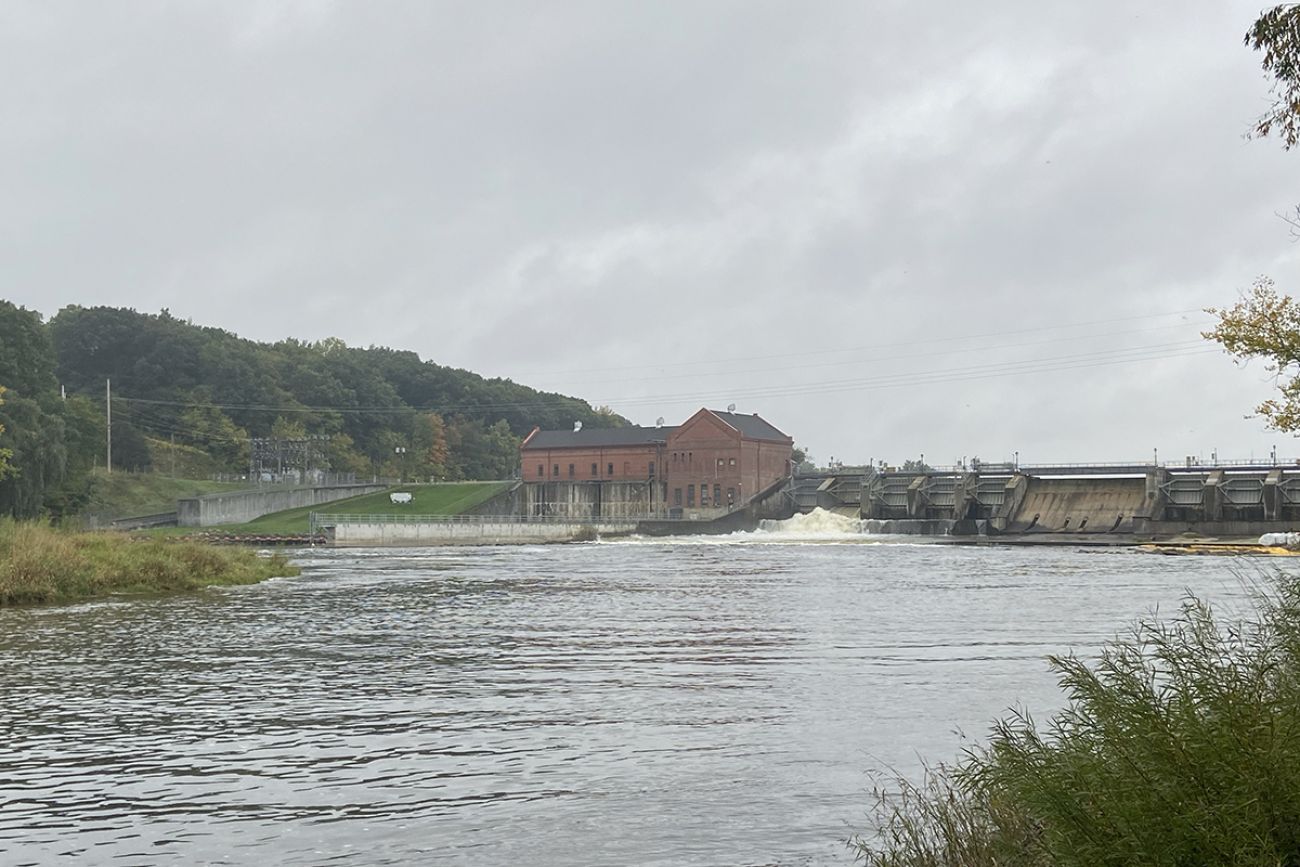Consumers Energy tells Michigan residents it needs partners to keep hydro dams

- Citing high costs and meager electricity, Consumers Energy hopes to sell its 13 river hydropower dams
- Most residents near the impoundments want to keep them around
- Without outside funding, doing so would cost Consumers customers $781 million, the company says
MUIR—The anxiety was palpable Wednesday evening as residents in this Ionia County community discussed the fate of a hydropower dam that has plugged a nearby stretch of the Grand River for more than a century.
For some, the 116-year-old Webber Dam is an asset that boosts the value of their lakeside property. For others, it’s a prized boating and fishing spot. Yet others see it as a safety hazard and river impediment that would be better off gone.
Related:
- Consumers’ decision on 13 dams could alter Michigan rivers, towns
- Uncertainty for Michigan rivers, residents as Consumers reconsiders its 13 dams
- Two years after Midland dam failures, still no action on safety reforms
- Michigan dams need ‘immediate attention’ to prevent next failure
But one thing’s certain, representative’s for the dam’s owner, Consumers Energy, told those gathered in the Muir Village Hall: Unless an outside funder emerges to cover rising maintenance costs at Webber and 12 other aging hydropower dams across the Lower Peninsula, it no longer makes sense for Consumers to keep owning them.
Taken together, the value of the power provided by the century-old dams is nowhere near enough to cover the hundreds of millions of dollars in maintenance and upgrades needed to continue operating them safely, according to the utility.
“We are not willing to pass these costs onto customers,” company spokesperson Josh Burgett told the crowd of about 100.

The conversation in Muir is part of a listening tour Consumers is conducting around the state this fall as the company ponders selling the dams. Depending whether the company finds a buyer, finds some other way to keep the impoundments intact, or opts to remove them and restore a free-flowing river, the process could dramatically reshape some of Michigan’s best-known waterways.
The 13 impoundments are located in the Au Sable, Manistee, Muskegon, Grand and Kalamazoo rivers.
Results of a survey commissioned by Consumers show the majority of people living near the dams want to see them kept in place, while a broader survey of Michigan residents yielded less enthusiasm.
That may not be surprising. The dams provide a host of localized benefits, but present an added cost to the rest of Consumers’ customers.
Continuing to operate all 13 hydropower dams would cost Consumers $781 million more than removing them, the company said. That would raise the average residential customer’s energy bill by $3.60 monthly for the next 60 years, with higher increases for businesses.
The energy they produce amounts to just 1 percent of Consumers power, and costs 9 times more than any of the company’s other power sources, such as coal, natural gas, wind and solar. After Consumers closes its final coal plant in 2025, that will rise to 15 times more expensive.
And dams come with other public costs, such as millions spent stocking native fish in rivers that have been degraded by the impoundments.
But locally, dams are an economic driver. Recreation at the impoundments creates 1,420 direct jobs and $140 million in gross domestic product, according to a survey from Public Sector Consultants, and the reservoirs created by the dams raise nearby residents’ property values by a combined $130 million.
In hopes of keeping dams intact without adding costs for customers, Consumers has applied for grants to maintain the structures. But the funding is competitive, and no money has been awarded so far.
“If (keeping dams intact) is your desire,” said Burgett of Consumers, “we're going to be at the table to try to make that a reality for you.”
But he added “we need partners to do that.”
One option is for local landowners to band together and tax themselves to cover the cost of maintaining the impoundments. That’s what happened near the Midland dams after taxpayers provided $200 million to rebuild them.
Kim Horrocks, who lives along the Webber Dam impoundment, said he'd be willing to pay something to keep the dams around. But with only dozens of homes adjacent to the reservoir, it’s unclear whether locals could pool enough money to cover the dam’s $1 million average annual operations and maintenance costs.
Horrocks expressed a belief that the dam’s value extends beyond those in the communities immediately surrounding it.
His preference, he said, is that “the body of water is maintained, and the dam keeps functioning.”
Brian Stelter said he sees more value in its removal. He lives just downstream of the impoundment, and fears for his safety if Consumers were to sell Webber to a new owner with less incentive to keep the impoundment safe. And as an avid river paddler, he said, he sees more recreational value in a free-flowing river than a reservoir.
“I know a lot of people love fishing the reservoirs,” he said. “But for the river runs, the salmon and steelhead, that's not the best thing for them.”
That’s a perspective shared by fish advocates and officials with the Michigan Department of Natural Resources, who told Consumers officials last year that the agency prefers dam removal wherever feasible.
While creating lake-like impoundments used by flatware anglers, dams fragment rivers and warm their water, harming coldwater fish like trout and salmon. And they trap sediments upstream, starving downstream reaches of nutrients while causing reservoirs to gradually fill with silt.
On Wednesday, one opinion seemed widespread among those in the room: If Consumers sells Webber Dam, it must be careful to find a buyer who will keep the structure safe.
Michigan’s Midland dam failures are a recent example of what can happen when private dam owners neglect needed maintenance.
“My concern,” Stelter said, “Is this going to be another dam failure in Michigan in the future in 30 years, because a company came in and bought the dam, and didn't take care of it.”
Burgett said Consumers hopes to find a single buyer interested in purchasing all 13 impoundments. Making sure they have enough resources to operate them safely is a “primary concern,” he said.
“We can’t just sell it to anybody.”
The company expects to officially launch its search for potential buyers before the end of the year. If a buyer emerges, any potential deal could take years to close.
Michigan Environment Watch
Michigan Environment Watch examines how public policy, industry, and other factors interact with the state’s trove of natural resources.
- See full coverage
- Subscribe
- Share tips and questions with Bridge environment reporter Kelly House
Michigan Environment Watch is made possible by generous financial support from:
Our generous Environment Watch underwriters encourage Bridge Michigan readers to also support civic journalism by becoming Bridge members. Please consider joining today.
See what new members are saying about why they donated to Bridge Michigan:
- “In order for this information to be accurate and unbiased it must be underwritten by its readers, not by special interests.” - Larry S.
- “Not many other media sources report on the topics Bridge does.” - Susan B.
- “Your journalism is outstanding and rare these days.” - Mark S.
If you want to ensure the future of nonpartisan, nonprofit Michigan journalism, please become a member today. You, too, will be asked why you donated and maybe we'll feature your quote next time!






